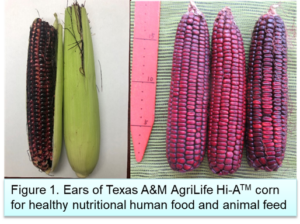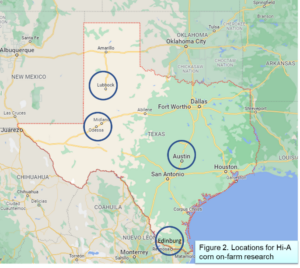Project Overview
Commodities
- Agronomic: corn
Practices
- Crop Production: plant breeding and genetics
Proposal abstract:
 The Texas A&M AgriLife corn breeding program in Lubbock focuses on developing superior corn inbred lines and hybrids with improved drought and heat tolerance, aflatoxin and fumonisin resistance, nutritional values, and yield potential. One type of our new pipelines is the Hi-A™ corn that have black or dark red kernels and contain high anthocyanin and high-antioxidants and these hybrids are well adapted to the Texas environments (Fig. 1). In addition, their cobs have 100 times more anthocyanins than conventional corn. Therefore, our Hi-A™ corn hybrids can produce healthy human food (such as black or red corn ears, large kernels, and colored flours) and of course animal feed. These high-value specialty corn will become a new source of food and feed and a new tool to generate income.
The Texas A&M AgriLife corn breeding program in Lubbock focuses on developing superior corn inbred lines and hybrids with improved drought and heat tolerance, aflatoxin and fumonisin resistance, nutritional values, and yield potential. One type of our new pipelines is the Hi-A™ corn that have black or dark red kernels and contain high anthocyanin and high-antioxidants and these hybrids are well adapted to the Texas environments (Fig. 1). In addition, their cobs have 100 times more anthocyanins than conventional corn. Therefore, our Hi-A™ corn hybrids can produce healthy human food (such as black or red corn ears, large kernels, and colored flours) and of course animal feed. These high-value specialty corn will become a new source of food and feed and a new tool to generate income.
The objective of this project is to conduct on-farm research and demonstrate the value of growing specialty Hi-A corn as a new source of high-value heathy food for humans and a nutritional feed for animals. Development of a commercial corn hybrid may take 10 years and involve two major steps: (a) develop superior inbred lines with desirable traits, (b) make a number of experimental hybrids by cross two inbred lines, (c) test the experimental hybrids in multiple environments for a few years and advance the best one for commercial production. Each step may take up to 5 years. With the funding from The Texas Corn Producers Board and the High Plains Underground Water Conservation District, we have reached the final stage of development with a new generation superior Hi-A™ corn hybrids that have acceptable quality for fresh produce market, human health benefits and good yields. Now that these High A hybrids are developed, this SARE grant will fund a system for integrating and establishing this technology on many small farms and ranches.
This project will lead to the adoption of unique high-value Hi-A corn hybrids along with the best management practices for producing highly nutritional human food and animal feed. This new genetic technology can allow producers to generate income in small areas and help concentrate limited irrigation resources, conserve water resources, and reduce production risks.
Project objectives from proposal:
 Field experiments: We will grow and evaluate the performance of two Hi-A™ corn hybrids TAMZ102 and TAMZ104 under two plant populations on farmer’s fields in four locations from north to south Texas (Lubbock, Odessa, Austin, and Edinburgh) as shown in Figure 2. These four locations represent major metropolitans and agriculture regions in Texas, have very diverse environments, and have a strong market for fresh corn. The Permian Basin has the greatest concentration of sheep and goat production. If our Hi-A corn-small ruminant systems works, then small ruminants could possibly be brought into those other areas and/or operations expanded.
Field experiments: We will grow and evaluate the performance of two Hi-A™ corn hybrids TAMZ102 and TAMZ104 under two plant populations on farmer’s fields in four locations from north to south Texas (Lubbock, Odessa, Austin, and Edinburgh) as shown in Figure 2. These four locations represent major metropolitans and agriculture regions in Texas, have very diverse environments, and have a strong market for fresh corn. The Permian Basin has the greatest concentration of sheep and goat production. If our Hi-A corn-small ruminant systems works, then small ruminants could possibly be brought into those other areas and/or operations expanded.
The experiment will use a split-plot design with three replications. The main plot is the plant populations, medium at 20,000 plants per acre and high at 25,000 plants per acre in order to determine which is the best hybrid-plant population combination for a specific farm. The sub-plot is hybrids. Each plot will be two-row, 20-ft long and 30-in row spacing. Detailed records will be recorded on all farming inputs (such as fertilizers, hours for field operation, irrigation), rainfall, number of plants per plot, pollen shedding and silking dates, plant and ear heights. All ears from 10-competitive plants will be harvested 30 days after silking, weighed, and rated for corn ear worm feeding damage, ear length, and overall quality. Fresh ears with husks will be cooked in a microwave for 5-min and tasted by the farm cooperators and their customers. The remaining ears will be sold as premium products by farmers. The total ears and unit price will be recorded to calculate the gross income and compare the profits of growing Hi-A corn with other vegetables.
Texas is the number one producer and exporter of goats and sheep in the United States. Our project will evaluate integrating Hi-A corn and sheep production that could lead to a tremendous economic benefit for producers. Hi-A corn ears are harvested 30 days after pollination (one month earlier than for grain), leaving plants that are still green. This plant material is usually “wasted” and may even create problems for producers to shred the stalks. This residue may represent about 16,000 lb/ac fresh biomass or 5,600 lb. of dry matter that could be available as feed for small ruminants (e.g. sheep). A 70-lb lamb can consume approximately 2.5 lb. of feed per day on a dry matter basis. Thus, one acre of corn residue is sufficient to feed 100 lambs for 22 days.
The seeds of the Hi-A hybrids for farmers to grow are currently not available commercially. The PI and his staff will increase the seeds of the parent lines for the hybrids and produce the hybrid seeds through hand pollination and by using isolation seed production field. We are working closely with seed companies to commercialize the germplasm developed by our corn breeding program. B-H Genetics, a family-owned regional seed company in Texas, is very interested in licensing the parent lines of the Hi-A hybrids TAMZ102 and TAMZ104 from Teas A&M University and market the hybrids in the U.S.
The project collaborators, Mr. Steve Paz and Ms. Kate Whitney from Texas A&M AgriLife Extension, will use the Hi-A corn fields at Austin and Odessa for their 4-H Youth and healthy-living extension programs. The research fields and products (fresh Hi-A corn ears) can provide educational opportunities to urban 4-H Youth, Master Gardeners and the general public who can come and learn how to plant and grow corn. Several meetings will be utilized to demonstrate the growth and production. Youth members will be educated in selection maturity of corn to market at the farmer’s market. Members will learn basic agronomy and livestock nutrition utilizing the corn stalk for feed.